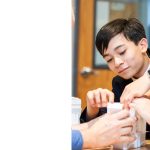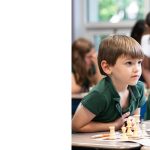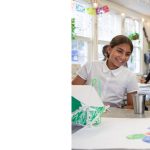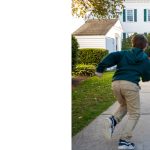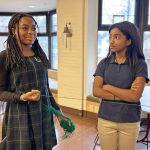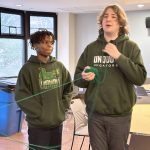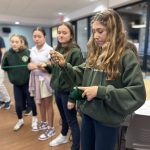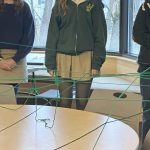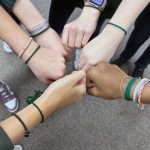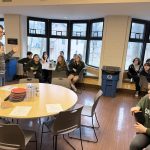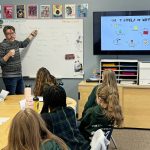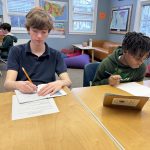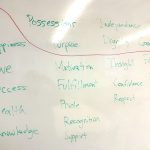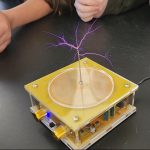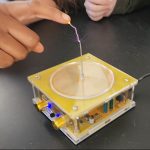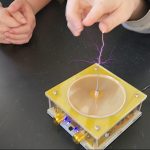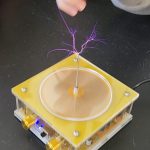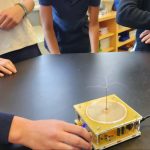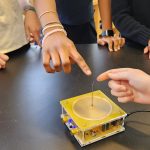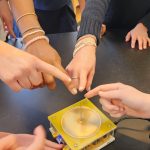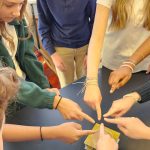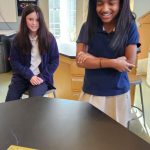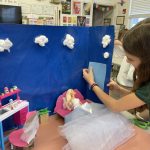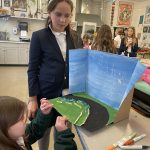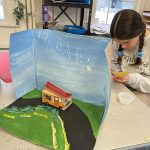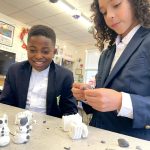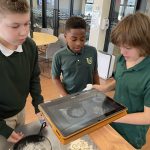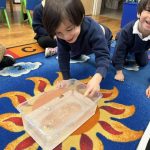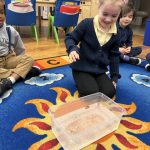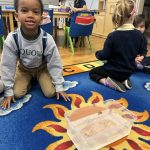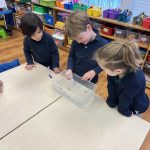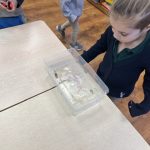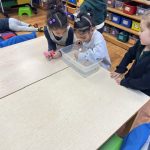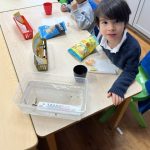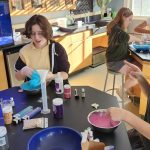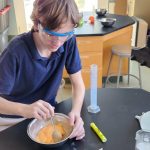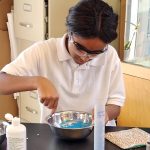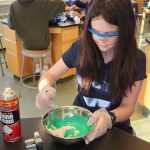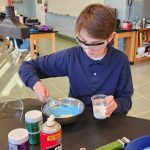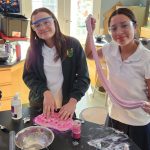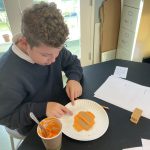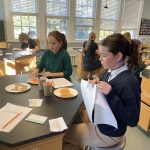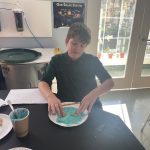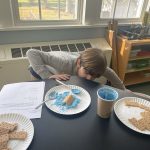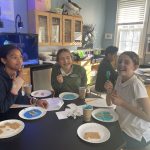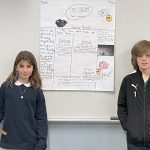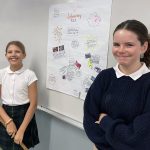Life Worth Living – Workshop Kick-off
Posted by Ariel WarshawOn Friday, February 2nd, 8th graders embarked on their first Life Worth Living workshop, facilitated by Dr. Matthew Croasmun, Director of the Life Worth Living Program at the Yale Center for Faith and Culture, and Unquowa faculty, Eric Snow and Ariel Warshaw. This workshop is part of our Life Worth Living ethics series, which includes 3 full morning workshops, and 5 sessions during Advisory. Prior to this first 3-hour morning program, students had explored elements of their own identity through reflection and guided conversations in Advisory, and then considered how societal perceptions influence their identity and desires.
We kicked off the workshop with a team-building exercise that asked the students to consider an element of their identity, and then pass a skein of yarn to a classmate to do the same. The result? A web of yarn that connected each of us to one another – there were lots of knots, some areas with more or less slack, and places we needed to repair. This served to symbolize our interconnectedness with one another, and how we can overcome challenges within ourselves and between each other. We concluded this exercise by cutting the yarn and tying a piece around our wrists, as a reminder of these lessons.
Dr. Croasmun then shared what brought him to consider, “What is really worth wanting in life?” This opened up to a larger conversation with the 8th graders around the question: “What are things people want?” They brainstormed dozens of responses – money, success, happiness, fame, health – and then considered which of these are “means” versus “ends.” Is money the ultimate goal? Or is it a means to achieve something deeper or more worth wanting, like happiness or security? We finished this portion of the workshop by learning about “The 7 Levels of Why”, which pushed students to ask “why?” from their wants, to delve deeper into their own motivations and desires.
We spent the last part of our workshop engaged in a Reflective Structured Dialogue (RSD). Three simultaneous conversations were held and facilitated by Dr. Croasmun, Eric Snow, and Ariel Warshaw. The students in each group opened the conversation by responding to the question, “What does responsibility mean to you?” Then, 8th graders unpacked the following: “Who determines what is worth wanting in life? Why? To whom am I responsible? To whom are we responsible?” Their responses were incredible – nuanced, deep, full of contradictions at times, and beautifully, imperfectly human.
We finished our workshop by looking at a few philosophical responses to these questions, looking at perspectives from Confucius (responsibility to parents), Asad Tarsinn (responsibility to God or a higher power), and Henry Taylor (responsibility to self).
We will continue to build on the theme of responsibility and the question, “What does good life look like?” over the coming weeks. As 8th graders begin to make decisions around and prepare for high school, the topics we explore will be integral to their thinking around what they truly want and who they truly are. We can’t wait to continue learning and growing with them in this process!
Plasma: The Fourth State of Matter
Posted by Joshua Bartosiewicz- Tesla Coil on! The bolts of electricity are actually ionized (supercharged) gas particles also known as “Plasma” which is the fourth state of matter.
- Giving the ionized particles a spot to discharge. This just feels like a tiny poke!
- When there’s nothing for the charged particles to escape to, they will be discharged into the path of least resistance in the gas molecules in the air!
- Changing the power and frequency of the Tesla coil.
- Everyone wants to feel the power of the Tesla coil!
- “Wow, that’s crazy it’s like mini lightening!”
As the 8th graders continue to venture into the realm of Chemistry, they’ve been learning about the states of matter and phase changes. Most people are aware of the three states of matter known as “solids, liquids and gasses”, however, there’s a fourth state of matter known as “plasma.” Not to confuse this with the plasma in our blood (they’re different), but the fourth state of matter called plasma is essentially supercharged gas particles. This state of matter makes up almost 99% of all matter in our universe! Here, on Earth, plasma can be seen as static shock, lightening, the aurora borealis or even in light bulbs and TVs!
In science we were able to utilize a Tesla Coil which was designed by Nikola Tesla in the 1800s to observe plasma in real life. When the machine was turned on, it starts producing electrical currents and builds up charges. The charges are discharged into the air around it, creating mini bolts of plasma. Students were able to manipulate where the discharges were released by moving their fingers to and from the coil. The discharges were hardly noticeable if they were even felt at all due to it being such a low intensity. The Tesla Coil allowed students to witness plasma in real time.
Stop Motion in the Art Studio!
Posted by Krissy PondenSixth graders have been planning, prepping, and storyboarding their stop motion animations, and soon they will begin recording! Stop motion is an awesome introduction to animation, and it can be easily made with a free app and a camera. Students have been experimenting with clay, legos, pencils on paper, and even Barbies! It is so much fun to see the students’ animations coming to life, and they are loving the process!
A Box of Snow
Posted by Faith BarbutoLast week we spent some outdoor time collecting a box of snow. We wondered what would happen if we took the snow inside, so we did. When we came in the next day, we found a box of water- dirty water! I reminded the students to think of this next time they are tempted to eat snow. We also noted that the tub of water was not full, even though it had been filled with snow. I explained that there is air trapped in the snow but not in between the water molecules. This week’s frigid cold gave us a new idea, what would happen to the water if we put it outside? We put it out and checked on it often, and it got cold but it wasn’t until the next morning that we discovered… a box of ice! The budding scientists were filled with more questions such as what would happen if we tried to write on it? We tried it! We knew that it would melt if we kept inside but how long would that take? By the end of the day it was almost all melted so of course, we decided to try to freeze it again. The next day we took out some thermometers to measure the temperature of the ice and water throughout the day. Just like the rest of us, it was freezing!!
Slime Time!
Posted by Joshua Bartosiewicz- Making the perfect Slime!
- Mixing orange slime!
- Observing the reaction between mixing glue, saline, baking soda and shaving cream!
- Making the Slime fluffier by adding shaving cream.
- Checking out the change in consistency.
- “This was so cool!”
In 8th grade science, the students are continuing their exploration in the realm of Chemistry. Before leaving for winter break we were able to squeeze in a couple of exciting labs. Our young scholars are beginning to understand how substances are composed of molecules and atoms and that there are various states of matter (i.e. Solids, Liquids, Gases and Plasma). In this lab, students were able to see substances change phases; by mixing glue, contact saline solution, baking soda and shaving cream. The concoction resulted in a thick gelatinous substance referred to as “Slime”. Seeing these reactions in person really changes your perspectives on the subject matter. In the end, all of the students had a wonderful time and were even able to bring home their science experiments!
Can We Eat This?
Posted by Colleen NoyesCan we eat this? is the question MOST asked before many experiments. There will only be one time that this is true for the 6th grade! It is the plate tectonics experiment where students simulate the movement of the Earth’s plates using graham crackers (sometimes gluten free) and frosting (magma). Science can be a tasty learning experience…….but don’t ask me again.
In addition the 6th grade made posters representing the way that rocks and minerals are formed. Each group researched their topic and created a poster. They are posted on the bulletin board in the science hallway, check them out! Test your knowledge and take the quiz!
It’s been a busy fall –




